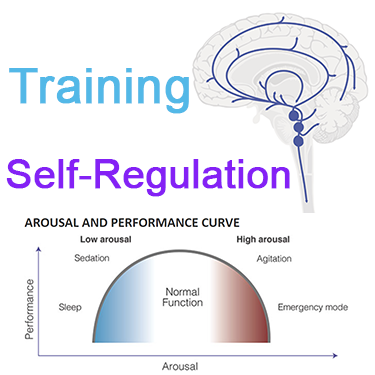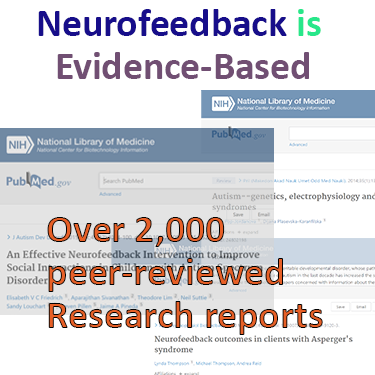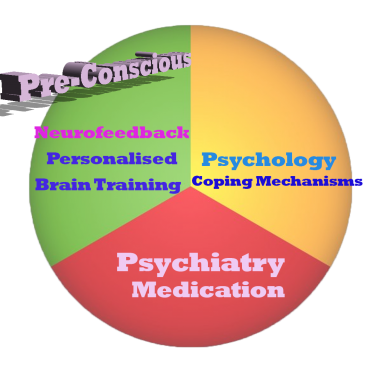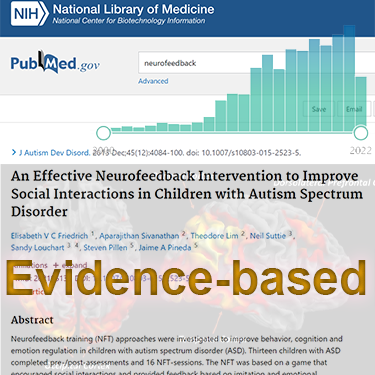Neurofeedback Training for Migraines
Neurofeedback is an effective, evidence-based method to reduce migraines.
The source and phenomenon of migraines is elusive. Elements in the brainstem that form part of our reticular activating system are suspected to be generators. Neurofeedback training seeks to calm this.
Studies have found cortical differences in migraineurs, which gives us the opportunity to train relevant brain areas. Notably these comprise parts of the Default Mode Network, which we aim to strengthen with neurofeedback.
Personalised Brain Training takes a holistic approach and we look for comorbid symptoms such as PTSD, sleep issues, mood regulation, focus and attention, and anxiety to improve. Neurofeedback is an evidence-based approach to these challenges.
Migraines can respond quickly, though often the process can be extended; secondary symptoms such as sleep, mood regulation, focus and anxiety should respond meanwhile. This usually becomes clear within the first few sessions.

Neurofeedback is a form of complementary therapy and should not be seen as a replacement for conventional medicine. qEEG brain map-based neurofeedback training takes a more holistic approach to brain functioning, rather than just focusing on medical symptoms. It is not intended as a form of diagnosis nor medical intervention nor medical advice per the disclaimer.
Proven Efficacy of Neurofeedback Training for Migraines
Efficacy of neurofeedback training is demonstrated in this study by Stokes / Lappin, conducted on 37 migraine patients with 40 neurofeedback sessions:
“All combined neuro and biofeedback interventions were effective in reducing the frequency of migraines with clients using medication resulting in a more favorable outcome (70% experiencing at least a 50% reduction in headaches) than just medications alone (50% experience a 50% reduction)…
These non-invasive interventions may show promise for treating treatment-refractory migraine and for preventing the progression from episodic to chronic migraine.”

In another study by J.E. Walker, of 71 persons migraine sufferers aged between 11-62, 46 chose to undergo neurofeedback raining, with the remaining 25 continuing only with drug therapy. The results were astounding:
“…neurofeedback appears to be dramatically effective in abolishing or significantly reducing migraine frequency in the great majority of patients with recurrent migraine headache…”
“For the neurofeedback group the majority (54%) experienced complete cessation of their migraines, and many others (39%) experienced a reduction in migraine frequency of greater than 50%. Four percent experienced a decrease in headache frequency of <50%. Only one patient did not experience a reduction in headache frequency.
The control group of subjects who chose to continue drug therapy as opposed to neurofeedback experienced no change in headache frequency (68%), a reduction of less than 50% (20%), or a reduction greater than 50% (8%). “
These results were achieved in just five training sessions per affected site, which ranged in number from one to four – between five and twenty neurofeedback sessions overall.
Note that results can vary; cases where substantially more sessions are required can occur.
Migraine-specific drugs such as triptans have been found to relieve headaches within 2 hours in 42-76% of patients, sustained headache relief (at 24 hours) of 29-50%, and sustained freedom of pain in 18-33%.
Neurofeedback and Sleep
Sleep is seen as one of the smoothing factors of migraine pain. Neurofeedback training has been shown to improve sleep quality in migraine patients.
Experiential Results from New Developments in Neurofeedback
Observations by the Othmers (see The Othmer Method of Neurofeedback) over two decades of clinical work suggest the following results:
- With modern ILF neurofeedback training there is now a high likelihood of aborting an ongoing migraine or at least of setting it upon a largely irreversible course toward resolution some time after the session is completed. With current practice, some 50% of migraines can be aborted within a 30-min session, and 80% of the remainder will be redirected from their normal trajectory toward resolution over the succeeding few hours.
- There appears to be no residual distinction in terms of efficacy between hormonally mediated and other migraines.
- Migraines may resolve so completely, even in long-term case histories of medically intractable migraines, that no further intervention is required, at least over typical periods of post-treatment follow-up care.
Migraines, Depression and other Comorbidities
Migraines often come with other comorbidities. Knowing one’s triggers and anticipating the onset of an episode can be as or more debilitating than the symptoms themselves. With neurofeedback, we can manage anxiety, depression and trauma while restoring motivation and focus.
Common migraine comorbidities include:
– anxiety (“not being able to stop or control worrying” on a daily basis, “trouble relaxing”, and “feeling nervous, anxious or on edge”) robustly correlates with migraine risk
– migraine sufferers are 2-4 times more likely to develop lifetime Major Depressive Disorder due to similar underlying genetic and pathophysiologic mechanisms
– chronic migraineurs are five times higher prevalence of PTSD (40%), and women are up to three times more prone than men
– strong association with ADHD, particularly in females
– a high prevalence of Restless Leg Syndrome, likely sharing dopaminergic processes
– the majority of migraineurs have Sleep Disorders
Testimonials
“After suffering from debilitating migraines for years, neurofeedback has done wonders for me. Knowing my triggers, for me the worst part of a migraine was not even the agonising paing that would leave me bed bound for days, but the anticipation of an episode which I could predict. The longer it took to arrive, the worse I knew it would be. I felt as if I was constantly hiding, from myself, from my friends; my colleagues, who would make fun of me during an attack; and from the optimisim I now feel. My migraines have stopped and I have regained my self-confidence thanks to Neurofeedback London.” – Tom
“Neurofeedback London gave me my life back. We started with a brain map, which accurately captured my behaviour patterns. The sessions are great, I watched movies I’ve always wanted to catch up on, and I felt the effect during the first session. The feedback was auditory, just the volume dropping subtly, so I found it comfortable and not triggering.
After ten sessions, my migraines were gone. I continued working on my anxiety and impulsiveness for another twenty sessions as I regained my self-esteem and look forward to continuing working with Daniel.” – Ashley
Note that individual results may vary.
Migraines affect about 20% of people at some point in their lives. It is considered the 6th most disabling condition by the WHO, and women are three times more at risk than males.
Migraines can be triggered by a variety of influences leading to neuronal overstimulation, and paradoxically and frustratingly can be both predictable and unpredictable. This makes their onset and at times debilitating symptoms difficult to treat and prevent, and invites a host of medical and alternative approaches. Their incapacitating nature and seemingly random occurrence gives rise to a range of further mental health issues, such as anxiety, depression, PTSD, sleep issues and general lack of focus and confidence.
With neurofeedback training, we are targeting core central nervous system dysregulation to stabilise it against head aches and other migraine symptoms, and further issues such as abdominal pain, PMS, vertigo and visual distortions (auras). We are also able to train specific brain areas that play a part in the accompanying manifestations such as mood and sleep disorders.
Neurofeedback training provides a drug-free, non-invasive treatment approach with proven and lasting efficacy. We can also address comorbidities such as anxiety, depression, PTSD and sleep issues.
Where a client presents with such a diagnosis, we rely on referral from and close collaboration with the respective medical professional. Neurofeedback London-Brighton does not provide diagnosis nor medical interventions.
Neurofeedback London-Brighton-Manchester uses the most advanced neurofeedback techniques, David Kaiser’s Neuromap for Personalised Brain Training and ILF / the Othmer Method.
Brain Maps and Personalised Brain Training Explained
Personalised Brain Training with Neurofeedback
Neurofeedback lets us train dysrythmic brain areas. With sensors comfortably fitted to the brain areas we want to train, we detect brainwave patterns real-time while watching a movie. When these patterns are inefficient, the volume drops momentarily. This is the feedback we are giving our brain, short and instantaneously.
The brain area we are training recognises this – while our conscious mind is focussed on the movie – and adjusts its behaviour to restore the normal volume. With repetition, throughout a session, learning occurs.
Meanwhile our conscious mind is solely focussed on the movie; the training process is passive in this sense.
The drop in volume is subtle, so we continue to understand the flow of the movie. No current or electrical stimulation is fed to the brain; sensors simply read brainwaves and the feedback is purely audio-visual.

Neurofeedback trains our Pre-Conscious Mind
Rather than engaging the conscious mind, which slows us down, we are training preconscious processes.
This equips us with the ability to live in the moment and attain our potential (if we have to resort to conscious control, we are not living in the moment).
We take a holistic approach to healthy brain self-regulation, rather than categorisation or diagnosis.
Personalised Brain Training is an advanced qEEG brain map-based approach to neurofeedback training developed by the founders of the field. Taking Othmer Method / ILF training methods further, it employs Default Network Training protocols as developed by David Kaiser.

Neurofeedback is Evidence-based
Neurofeedback training is an evidence-based complementary therapy. Its efficacy was first demonstrated some 50 years ago, and with advances in technology, training protocols have become more efficient and the feedback method – watching movies – thoroughly enjoyable.
Neurofeedback is evidence-based. It’s first application was discovered in 1971 when it was used to resolve intractable epilepsy.
There are over 2,000 peer-reviewed research reports on PubMed demonstrating efficacy across a number of pathologies.
In the US, it is an accepted complementary treatment for many challenges.